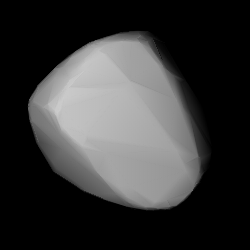Astronomy:1189 Terentia
 Modelled shape of Terentia from its lightcurve | |
| Discovery[1] | |
|---|---|
| Discovered by | G. Neujmin |
| Discovery site | Simeiz Obs. |
| Discovery date | 17 September 1930 |
| Designations | |
| (1189) Terentia | |
| Named after | Lidiya Terent'eva (orbit computer)[2] |
| 1930 SG · 1935 SK2 A915 TJ | |
| Minor planet category | main-belt · (outer)[3] Terentia[4] |
| Orbital characteristics[1] | |
| Epoch 4 September 2017 (JD 2458000.5) | |
| Uncertainty parameter 0 | |
| Observation arc | 101.46 yr (37,057 days) |
| |{{{apsis}}}|helion}} | 3.2681 AU |
| |{{{apsis}}}|helion}} | 2.5914 AU |
| 2.9298 AU | |
| Eccentricity | 0.1155 |
| Orbital period | 5.01 yr (1,832 days) |
| Mean anomaly | 103.65° |
| Mean motion | 0° 11m 47.4s / day |
| Inclination | 9.8671° |
| Longitude of ascending node | 275.24° |
| 95.571° | |
| Physical characteristics | |
| Dimensions | 55.40±14.41 km[5] 55.88±3.2 km[6] 55.94 km (derived)[3] 57.23±17.09 km[7] 59.246±0.201 km[8] 61.140±1.045 km[9] 62.81±0.85 km[10] 70.90±0.51 km[11] |
| Rotation period | 19.30±0.01 h[12] 19.308±0.002 h[13] |
| Geometric albedo | 0.042±0.006[11] 0.045±0.001[10] 0.0473±0.0053[9] 0.05±0.04[5][7] 0.0566±0.007[6] 0.0619 (derived)[3] |
| SMASS = Ch[1] · C[3] | |
| Absolute magnitude (H) | 9.80[5][11] · 9.84±0.26[14] · 9.9[1] · 9.96[7][3] · 10.00[6][9][10] |
1189 Terentia, provisional designation 1930 SG, is a carbonaceous Terentian asteroid from the outer regions of the asteroid belt, approximately 56 kilometers in diameter and the namesake of its family. The asteroid was discovered by Russian astronomer Grigory Neujmin at Simeiz Observatory on 17 September 1930.[15]
Classification
Terentia is the namesake of the Terentia family (618), a small asteroid family of less than a hundred known members of a carbonaceous C-type composition orbiting in the outer main-belt.[4]
Orbit
Terentia orbits the Sun at a distance of 2.6–3.3 AU once every 5.01 years (1,832 days). Its orbit has an eccentricity of 0.12 and an inclination of 10° with respect to the ecliptic.[1] The body's observation arc begins at Simeiz, 5 days after its official discovery observation.[15]
Physical characteristics
In the SMASS taxonomy, is classified as a Ch-type, a hydrated subtype of the carbonaceous C-type asteroids.[1]
Naming
This minor planet was named after Lidiya Terent'eva (1879–1933), female collaborator at the Simeis Observatory.[1]
References
- ↑ 1.0 1.1 1.2 1.3 1.4 1.5 1.6 "JPL Small-Body Database Browser: 1189 Terentia (1930 SG)". Jet Propulsion Laboratory. https://ssd.jpl.nasa.gov/sbdb.cgi?sstr=2001189. Retrieved 16 August 2017.
- ↑ Schmadel, Lutz D. (2007). "(1189) Terentia". Dictionary of Minor Planet Names. Springer Berlin Heidelberg. p. 100. doi:10.1007/978-3-540-29925-7_1190. ISBN 978-3-540-00238-3.
- ↑ 3.0 3.1 3.2 3.3 3.4 "LCDB Data for (1189) Terentia". Asteroid Lightcurve Database (LCDB). http://www.minorplanet.info/PHP/generateOneAsteroidInfo.php?AstInfo=1189%7CTerentia. Retrieved 16 August 2017.
- ↑ 4.0 4.1 Nesvorný, D.; Broz, M.; Carruba, V. (December 2014). "Identification and Dynamical Properties of Asteroid Families". Asteroids IV. pp. 297–321. doi:10.2458/azu_uapress_9780816532131-ch016. ISBN 9780816532131. Bibcode: 2015aste.book..297N.
- ↑ 5.0 5.1 5.2 Nugent, C. R.; Mainzer, A.; Masiero, J.; Bauer, J.; Cutri, R. M.; Grav, T. et al. (December 2015). "NEOWISE Reactivation Mission Year One: Preliminary Asteroid Diameters and Albedos". The Astrophysical Journal 814 (2): 13. doi:10.1088/0004-637X/814/2/117. Bibcode: 2015ApJ...814..117N. http://adsabs.harvard.edu/cgi-bin/bib_query?bibcode=2015ApJ...814..117N. Retrieved 16 August 2017.
- ↑ 6.0 6.1 6.2 Tedesco, E. F.; Noah, P. V.; Noah, M.; Price, S. D. (October 2004). "IRAS Minor Planet Survey V6.0". NASA Planetary Data System 12: IRAS-A-FPA-3-RDR-IMPS-V6.0. Bibcode: 2004PDSS...12.....T. https://sbnarchive.psi.edu/pds3/iras/IRAS_A_FPA_3_RDR_IMPS_V6_0/data/diamalb.tab. Retrieved 22 October 2019.
- ↑ 7.0 7.1 7.2 Nugent, C. R.; Mainzer, A.; Bauer, J.; Cutri, R. M.; Kramer, E. A.; Grav, T. et al. (September 2016). "NEOWISE Reactivation Mission Year Two: Asteroid Diameters and Albedos". The Astronomical Journal 152 (3): 12. doi:10.3847/0004-6256/152/3/63. Bibcode: 2016AJ....152...63N.
- ↑ Masiero, Joseph R.; Grav, T.; Mainzer, A. K.; Nugent, C. R.; Bauer, J. M.; Stevenson, R. et al. (August 2014). "Main-belt Asteroids with WISE/NEOWISE: Near-infrared Albedos". The Astrophysical Journal 791 (2): 11. doi:10.1088/0004-637X/791/2/121. Bibcode: 2014ApJ...791..121M. http://adsabs.harvard.edu/cgi-bin/bib_query?bibcode=2014ApJ...791..121M. Retrieved 16 August 2017.
- ↑ 9.0 9.1 9.2 Mainzer, A.; Grav, T.; Masiero, J.; Hand, E.; Bauer, J.; Tholen, D. et al. (November 2011). "NEOWISE Studies of Spectrophotometrically Classified Asteroids: Preliminary Results". The Astrophysical Journal 741 (2): 25. doi:10.1088/0004-637X/741/2/90. Bibcode: 2011ApJ...741...90M.
- ↑ 10.0 10.1 10.2 Usui, Fumihiko; Kuroda, Daisuke; Müller, Thomas G.; Hasegawa, Sunao; Ishiguro, Masateru; Ootsubo, Takafumi et al. (October 2011). "Asteroid Catalog Using Akari: AKARI/IRC Mid-Infrared Asteroid Survey". Publications of the Astronomical Society of Japan 63 (5): 1117–1138. doi:10.1093/pasj/63.5.1117. Bibcode: 2011PASJ...63.1117U. (online, AcuA catalog p. 153)
- ↑ 11.0 11.1 11.2 Masiero, Joseph R.; Mainzer, A. K.; Grav, T.; Bauer, J. M.; Cutri, R. M.; Nugent, C. et al. (November 2012). "Preliminary Analysis of WISE/NEOWISE 3-Band Cryogenic and Post-cryogenic Observations of Main Belt Asteroids". The Astrophysical Journal Letters 759 (1): 5. doi:10.1088/2041-8205/759/1/L8. Bibcode: 2012ApJ...759L...8M. http://adsabs.harvard.edu/cgi-bin/bib_query?bibcode=2012ApJ...759L...8M. Retrieved 16 August 2017.
- ↑ Stephens, R. D. (September 2002). "Photometry of 973 Aralia, 1189 Terentia, 1040 Klumpkea, and 1998 Titius". The Minor Planet Bulletin 29: 47–48. Bibcode: 2002MPBu...29...47S. http://adsabs.harvard.edu/cgi-bin/bib_query?bibcode=2002MPBu...29...47S. Retrieved 16 August 2017.
- ↑ Behrend, Raoul. "Asteroids and comets rotation curves – (1189) Terentia". Geneva Observatory. http://obswww.unige.ch/~behrend/page3cou.html#001189. Retrieved 16 August 2017.
- ↑ Veres, Peter; Jedicke, Robert; Fitzsimmons, Alan; Denneau, Larry; Granvik, Mikael; Bolin, Bryce et al. (November 2015). "Absolute magnitudes and slope parameters for 250,000 asteroids observed by Pan-STARRS PS1 - Preliminary results". Icarus 261: 34–47. doi:10.1016/j.icarus.2015.08.007. Bibcode: 2015Icar..261...34V. http://adsabs.harvard.edu/cgi-bin/bib_query?bibcode=2015Icar..261...34V. Retrieved 16 August 2017.
- ↑ 15.0 15.1 "1189 Terentia (1930 SG)". Minor Planet Center. https://www.minorplanetcenter.net/db_search/show_object?object_id=1189. Retrieved 16 August 2017.
External links
- Asteroid Lightcurve Database (LCDB), query form (info )
- Dictionary of Minor Planet Names, Google books
- Asteroids and comets rotation curves, CdR – Observatoire de Genève, Raoul Behrend
- Discovery Circumstances: Numbered Minor Planets (1)-(5000) – Minor Planet Center
- 1189 Terentia at AstDyS-2, Asteroids—Dynamic Site
- 1189 Terentia at the JPL Small-Body Database
 |

